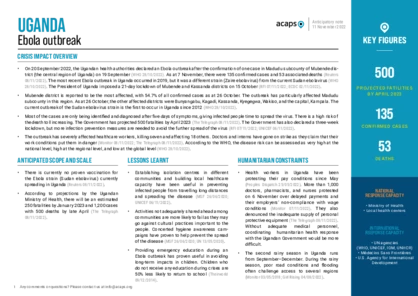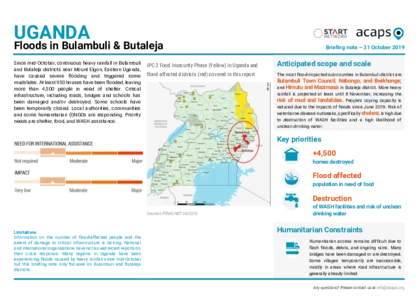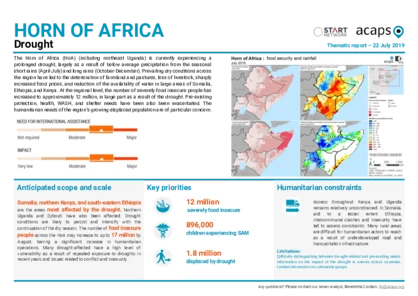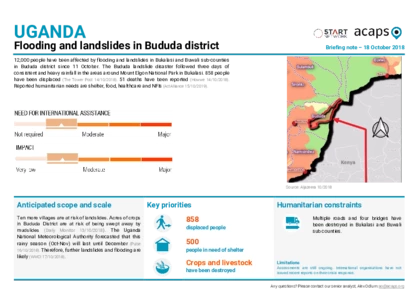Latest updates on country situation
26 August 2025
Floods and landslides in Uganda’s Mount Elgon subregion have killed five people, injured over 50, and affected 15,000, including over 5,000 displaced. In Bulambuli, Mbale, Namisindwa, and Sironko districts, homes, crops, livestock, and infrastructure have been destroyed. Immediate needs include shelter, food, health and WASH services, household items, and psychosocial support. (ECHO 22/08/2025, GDACS accessed 26/08/2025)
24 June 2025
Between January and mid-June 2025, around 66,800 new refugees from eastern Democratic Republic of Congo arrived in Uganda. Most of them were women and children who crossed into Kisoro district. The sudden influx has placed significant pressure on Uganda’s already overstretched refugee response system. Key transit centres are operating far beyond their intended capacity. Nyakabande transit centre in Kisoro district is hosting nearly six times its 1,500-person limit, resulting in critical gaps in WASH, protection, health, and nutrition services. The rainy season (March–July) may aggravate the situation, leading to flooding, deteriorated living conditions, and the risk of waterborne diseases, such as cholera. A recent nutrition screening reported global acute malnutrition rates exceeding the 15% emergency threshold in several sites. Uganda, already hosting over 1.9 million refugees, faces increasing challenges in sustaining humanitarian services, while protection risks for children, including violence and lack of education access, remain high. ([UNICEF 23/06/2025](https://www.unicef.org/esa/reports/regional-impact-drc-crisis , The EastAfrican 23/06/2025, UNHCR 15/06/2025)
24 September 2024
Between 9 August and 10 September 2024, unexpected rains in Uganda's western region led to severe flooding in the districts of Bundibugyo, Bunyagabu, Kasese, and Ntoroko, with heavy storms causing a landfill collapse in Kampala. The rains affected nearly 44,400 people and displaced approximately 25,400. Some of the affected districts host refugees. Immediate needs include healthcare services, food aid, and NFIs. The floods caused significant infrastructure damage, with homes destroyed and key facilities like water points, schools, and health centres severely affected. (IOM 23/09/2024, ECHO 10/09/2024, IFRC 30/08/2024)
21 May 2024
Between January–April 2024, heavy rains, floods, and landslides affected over 52,000 individuals, killing 23 people and injuring 241. The rainy season (March-May) triggered landslides and mudslides in the Elgon and Rwenzori Mountain Ranges, accompanied by floods, heavy storms, and lightning. There has been significant infrastructural damage, with over 1,720 houses destroyed, 1,400 houses damaged, and 147 water facilities, 16 schools, and eight health facilities severely affected. The most urgent needs include food, shelter, and NFI assistance. In Nakasongola district, over 200 families from 21 villages in Lwampanga subcounty and Lwampanga Town Council are stranded after losing property to fresh Lake Kyoga floods, which have destroyed over 80% of road infrastructure. According to the Uganda Red Cross, in May, flooding affected nearly 39,190 people and displaced approximately 3,000 families across 14 districts. The Uganda National Meteorological Authority forecasts continued rainfall throughout May. (OCHA 21/05/2024, Monitor 20/05/2024, IFRC/Uganda Red Cross 12/05/2024)
19 February 2024
Uganda has been experiencing a significant influx of refugees, receiving nearly 15,000 since January 2024, primarily because of conflict in neighbouring countries, including eastern Democratic Republic of Congo (DRC), South Sudan, and Sudan. Of these refugees, more than 3,000 are from the DRC alone. Uganda is one of the largest refugee-hosting nations globally, and this influx adds to the 1.6 million already hosted in the country, most of whom are from South Sudan. The surge has increased pressure on the already limited resources in the wetland and natural areas around Lake Albert. It has also placed immense strain on the Kyangwali Refugee Settlement, which is currently struggling to accommodate the growing population with limited resources. As at August 2023, the camp was housing approximately 131,000 refugees. UNHCR anticipates a further rise in refugee numbers, particularly from the DRC and Sudan, as conflicts continue to escalate throughout 2024. (UNHCR 04/08/2023, Monitor 18/02/2024, Xinhua 19/02/2024)
current crises
in
Uganda
These crises have been identified through the INFORM Severity Index, a tool for measuring and comparing the severity of humanitarian crises globally.
UGA005 - International displacement
Last updated 14/11/2025
Drivers
International Displacement
Crisis level
Country
Severity level
3.1 High
Access constraints
0.0
Analysis products
on
Uganda
04 November 2019
Uganda: Floods in Bulambuli and Butaleja
DOCUMENT / PDF / 357 KB
Since mid-October, continuous heavy rainfall in Bulambuli and Butaleja districts near Mount Elgon, Eastern Uganda, have caused severe flooding and triggered some mudslides. At least 950 houses have been flooded, leaving more than 4,500 people in need of shelter. Critical infrastructure, including roads, bridges and schools has been damaged and/or destroyed. Some schools have been temporarily closed. Local authorities, communities and some humanitarian (I)NGOs are responding. Priority needs are shelter, food, and WASH assistance.
22 July 2019
Horn of Africa: Drought
DOCUMENT / PDF / 830 KB
The Horn of Africa (including northeast Uganda) is currently experiencing a prolonged drought, largely as a result of below average precipitation from the seasonal short rains (April-July) and long rains (October-December). Prevailing dry conditions across the region have led to the deterioration of farmland and pastures, loss of livestock, sharply increased food prices, and reduction of the availability of water in these areas.
18 October 2018
Uganda: Flooding and landslides in Bududa
DOCUMENT / PDF / 644 KB
12,000 people have been affected by flooding and landslides in Bukalasi and Buwali sub-counties in Bududa district since 11 October. The Bududa landslide disaster followed three days of consistent and heavy rainfall in the areas around Mount Elgon National Park in Bukalasi. 858 people have been displaced. 51 deaths have been reported. Reported humanitarian needs are shelter, food, healthcare and NFIs.
22 August 2018
Uganda: Anticipation of the Ebola Virus Disease
DOCUMENT / PDF / 355 KB
As of 18 August, 91 cases of Ebola and 50 deaths (CFR 54.9%) have been reported in Ituri and Nord Kivu provinces of DRC. Conflict and insecurity in both areas are aggravating the crisis and increasing the risk the disease will spread further. Conflict is hampering humanitarian access of health workers to the local population, as well as driving displacement across the border to Uganda.






